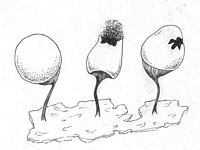|
 Arcyria leiocarpa Arcyria leiocarpa
SynonymsHemiarcyria leiocarpa
Hyporrhama leiocarpa
Arcyria leiocarpa
BiostatusPresent in region - Indigenous. Non endemic
Images (click to enlarge)
Caption: sporangia of Arcyria leiocarpa, each of which is about 1 mm tall.
Owner: S.L. Stephenson |
Article: Stephenson, S.L. (2003). Myxomycetes of New Zealand. Fungi of New Zealand. Ngā Harore o Aotearoa 3: xiv + 238 p. Hong Kong: Fungal Diversity Press.
Description: Fruiting body a stalked sporangium, usually scattered, up to 1.5 mm tall. Sporotheca typically cylindrical but varying to ovate or subglobose, pale grey or ochraceous, 0.4–0.7 mm in diameter. Stalk slender, cylindrical, 0.5–1.0 tall, or somewhat darker, filled with spore-like cysts. Hypothallus discoid or contiguous for a group of sporangia, sometimes silvery but usually inconspicuous. Peridium persisting in mature fruiting bodies only as a distinct calyculus, the latter shallow, fluted. Capillitium a loose net of branching and anastomosing, tubular threads, firmly attached, rather weakly elastic, 3–5 µm in diameter, bearing 3–5 usually fairly prominent but sometimes faint spirals, smooth or spiny or in part replaced by spines. Spores grey to ochraceous in mass, nearly colourless by transmitted light, faintly and sparsely warted, 7–9 µm in diameter. Plasmodium colourless, turning white before fruiting.
Habitat: Decaying wood, dead leaves, humus-rich soil, the bark of living trees, and dung of herbivorous animals.
Distribution: Reported from widely scattered localities in North America, Central America, South America, and Europe (Martin & Alexopoulos 1969) but not common. First reported from New Zealand by Mitchell (1992), based on a specimen appearing in moist chamber culture on bark samples of Nothofagus sp. collected in Otago Lakes. Also known from Campbell Island.
Notes: Although Arcyria leiocarpa has the general appearance of a typical member of the genus Arcyria, the usually prominent spiral bands on the capillitium are similar to those found in such genera as Hemitrichia and Trichia. For this reason, some authors (e.g., Lado & Pando 1997) prefer to place this species in the genus Hemitrichia as H. leiocarpa. Nannenga-Bremekamp (1991) outlined the reasons for retaining it in Arcyria, which is the concept followed herein.
|